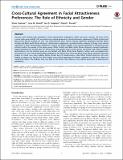Files in this item
Cross-cultural agreement in facial attractiveness preferences : the role of ethnicity and gender
Item metadata
| dc.contributor.author | Coetzee, Vinet | |
| dc.contributor.author | Greeff, Jaco M. | |
| dc.contributor.author | Stephen, Ian D. | |
| dc.contributor.author | Perrett, David I. | |
| dc.date.accessioned | 2015-05-12T09:31:01Z | |
| dc.date.available | 2015-05-12T09:31:01Z | |
| dc.date.issued | 2014-07-02 | |
| dc.identifier | 152904284 | |
| dc.identifier | b1c4024c-8f33-4fab-ba14-297f5ec53aa6 | |
| dc.identifier | 000341354100016 | |
| dc.identifier | 84903783349 | |
| dc.identifier | 000341354100016 | |
| dc.identifier.citation | Coetzee , V , Greeff , J M , Stephen , I D & Perrett , D I 2014 , ' Cross-cultural agreement in facial attractiveness preferences : the role of ethnicity and gender ' , PLoS ONE , vol. 9 , no. 7 , e99629 . https://doi.org/10.1371/journal.pone.0099629 | en |
| dc.identifier.issn | 1932-6203 | |
| dc.identifier.other | ORCID: /0000-0002-6025-0939/work/64360911 | |
| dc.identifier.uri | https://hdl.handle.net/10023/6633 | |
| dc.description.abstract | Previous work showed high agreement in facial attractiveness preferences within and across cultures. The aims of the current study were twofold. First, we tested cross-cultural agreement in the attractiveness judgements of White Scottish and Black South African students for own-and other-ethnicity faces. Results showed significant agreement between White Scottish and Black South African observers' attractiveness judgements, providing further evidence of strong cross-cultural agreement in facial attractiveness preferences. Second, we tested whether cross-cultural agreement is influenced by the ethnicity and/or the gender of the target group. White Scottish and Black South African observers showed significantly higher agreement for Scottish than for African faces, presumably because both groups are familiar with White European facial features, but the Scottish group are less familiar with Black African facial features. Further work investigating this discordance in cross-cultural attractiveness preferences for African faces show that Black South African observers rely more heavily on colour cues when judging African female faces for attractiveness, while White Scottish observers rely more heavily on shape cues. Results also show higher cross-cultural agreement for female, compared to male faces, albeit not significantly higher. The findings shed new light on the factors that influence cross-cultural agreement in attractiveness preferences. | |
| dc.format.extent | 8 | |
| dc.format.extent | 296151 | |
| dc.language.iso | eng | |
| dc.relation.ispartof | PLoS ONE | en |
| dc.subject | Mate preferences | en |
| dc.subject | Physical attractiveness | en |
| dc.subject | Womens preferences | en |
| dc.subject | Face recognition | en |
| dc.subject | Race | en |
| dc.subject | Health | en |
| dc.subject | Beauty | en |
| dc.subject | Clor | en |
| dc.subject | Judgments | en |
| dc.subject | Identification | en |
| dc.subject | BF Psychology | en |
| dc.subject.lcc | BF | en |
| dc.title | Cross-cultural agreement in facial attractiveness preferences : the role of ethnicity and gender | en |
| dc.type | Journal article | en |
| dc.contributor.institution | University of St Andrews. School of Psychology and Neuroscience | en |
| dc.contributor.institution | University of St Andrews. Institute of Behavioural and Neural Sciences | en |
| dc.contributor.institution | University of St Andrews. Centre for Social Learning & Cognitive Evolution | en |
| dc.identifier.doi | https://doi.org/10.1371/journal.pone.0099629 | |
| dc.description.status | Peer reviewed | en |
| dc.identifier.url | http://journals.plos.org/plosone/article?id=10.1371/journal.pone.0099629#s5 | en |
This item appears in the following Collection(s)
Items in the St Andrews Research Repository are protected by copyright, with all rights reserved, unless otherwise indicated.

